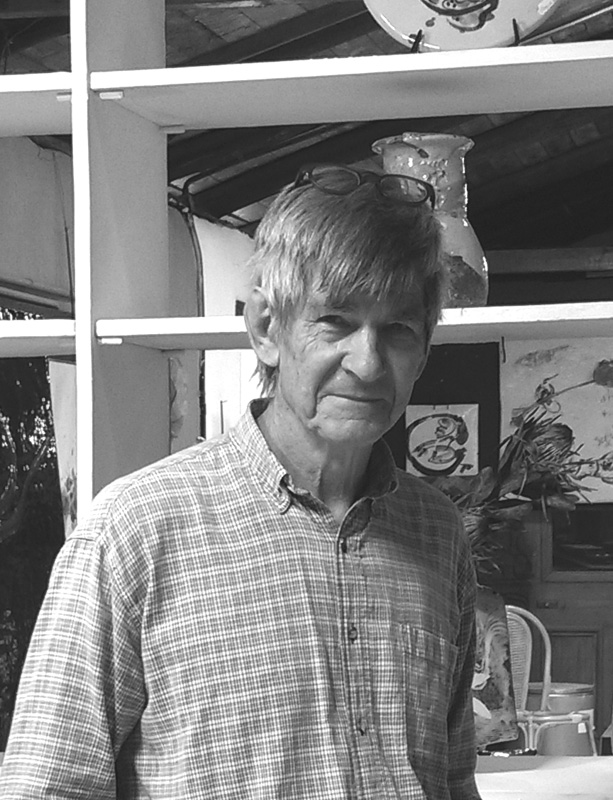Folded vase
£300.00Stoneware vase by Andrew Walford
280 x 270 x 130 mm

Internationally acclaimed potter Andrew Walford has been working in his mountain-top studio overlooking the Shongweni dam and game reserve for 50 years. In 1947, aged five, he arrived in Africa with his family in a wooden aeroplane and, apart from a couple of years in Europe in the Sixties, he has been working and dreaming in the exquisitely scenic green hills of KwaZulu-Natal ever since.
Andrew studied at Durban Art School from 1957-59 and then was an apprentice with Walsh Marais and Sammy Liebermann until establishing his own studio in Durban in 1961. In 1964 he travelled to Europe, where he met Bernard Leach, Lucie Rie and Michael Cardew. He established a studio in Staufen, Germany in 1965, and then taught at the Hamburg Academy of Art from 1966-68. He returned to Africa in 1968 and after travelling to Asia and meeting with Shoji Hamada, he established a new studio in the Shongweni Hills in 1970.
Andrew works in the Japanese tradition but is inspired by the spectacular indigenous bush surrounding his home and work-shop. He draws on local trees and flowers for his decorative inspiration and is never separate from the nature all around him and an encompassing Zulu culture. However, he follows an inner Eastern philosophy and adheres to a Japanese ethos in his meticulous method of working and in his use of minimalist brush strokes. He has even been described as KwaZulu-Natal’s Zen Potter.
Andrew digs his own stoneware clay high up on a wild wind-swept ridge in the Drakensberg and carefully prepares it by hand to his own requirements. Water used is from a spring near his home and he works with thick chun glazes sifted by hand from wood ash and burnt native grass, in colours of rich resonant tenmokus, fatty whites and shades of celadon. His enormous oil burning kiln takes 24 hours to fire and reaches a white heat of 1380 degrees C. It is a reduction atmosphere which needs constant attention whilst starving the atmosphere of oxygen and at the same time keeping the heat rising gradually. The length of flame is critical and the amount of smoke can change in seconds from a wisp to a black cloud if not controlled. It then takes 3 days to cool before Andrew gingerly takes the first brick out of the door to see the results of two months’ work.
Andrew has been making wall tiles for almost the whole of his ceramic production life but over the years his techniques have changed and style become more refined and varied. He uses a paper clay mixture which includes shredded paper, porcelain and stoneware clay. He decorates with Japanese brushes and often includes dashes of indigenous wood ash glaze and evanescent celadons or Chinese chuns which change with variations in light and season, echoing the ever changing glow on the sandstone krantz and fields of burnt sugar cane surrounding his workplace. The natural colours on the pots are reminiscent of the reflecting afternoon sun and shadows on the cliffs which rise steeply next to his home, which he shares with his wife Leanda.
Andrew’s work has been exhibited worldwide from Japan to USA; South Korea to UK and across mainland Europe.
Showing all 20 resultsSorted by latest
Stoneware vase by Andrew Walford
280 x 270 x 130 mm
Stoneware vase by Andrew Walford
270 x 180 mm
Stoneware vase by Andrew Walford
170 x 340 x 120 mm
Porcelain vase by Andrew Walford
120 x 160 x 120 mm
Porcelain tile by Andrew Walford
25 x 230 x 210 mm
Stoneware tile by Andrew Walford
20 x 600 x 850 mm
Stoneware tile by Andrew Walford
20 x 440 x 350 mm
Porcelain bowl by Andrew Walford
40 x 290 mm
Porcelain bowl by Andrew Walford
40 x 240 mm
Porcelain bowl by Andrew Walford
40 x 210 mm
Porcelain bottle by Andrew Walford
450 x 380 x 90 mm
Porcelain bowl by Andrew Walford
70 x 110 mm
Porcelain bowl by Andrew Walford
60 x 120 mm
Stoneware tea bowl by Andrew Walford
80 x 100 mm
Stoneware tea bowl by Andrew Walford
80 x 100 mm
Porcelain dish by Andrew Walford
30 x 110 mm
Porcelain dish by Andrew Walford
30 x 110 mm
Porcelain bowl by Andrew Walford
90 x 170 mm
Porcelain bowl by Andrew Walford
80 x 140 mm
Stoneware platter by Andrew Walford
30 x 380 x 220 mm